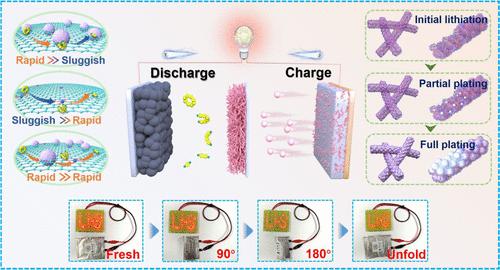通过纳米级不对称尺寸协同作用激发硫/锂的强劲电化学性能
IF 15.6
1区 化学
Q1 CHEMISTRY, MULTIDISCIPLINARY
引用次数: 0
摘要
缓慢的氧化还原动力学和枝晶生长阻碍了锂硫(li -硫)电池高效电化学的实现。复杂的硫相变和硫/锂多样性动力学要求在催化剂设计中采用包罗万象的方法。本文通过整合Co单原子和缺陷CoTe2-x (CoSA-CoTe2 - x@NHCF),精心开发了一种具有纳米尺度不对称结构的兼容介质,用于同步调节硫/锂电化学。大量的电化学和理论分析表明,CoTe2-x在长链多硫转化和Li2S分解中表现出更高的催化活性,而单分散的Co位点更有效地促进硫还原动力学,调节Li2S沉积。这种级联催化作用使CoSA-CoTe2 - x@NHCF在整个氧化还原反应过程中为硫种提供了“捕集-转化-回收”的全方位服务。此外,原位透射电镜显示,初始形成的电导性Co和离子导电性Li2Te提供了足够的亲锂位点来调节均匀的锂电镀和剥离,显著抑制枝晶生长。因此,通过耦合CoSA-CoTe2 - x@NHCF中间层和Li@CoSA-CoTe2 - x@NHCF阳极,构建的Li-S全电池具有卓越的循环稳定性和倍率性能,并且柔性袋状电池在0.3 c下具有稳定的循环性能。对非对称尺寸结构的协同效应的深入研究为先进Li-S系统的集成催化剂设计铺平了道路。本文章由计算机程序翻译,如有差异,请以英文原文为准。

Energizing Robust Sulfur/Lithium Electrochemistry via Nanoscale-Asymmetric-Size Synergism
Sluggish redox kinetics and dendrite growth perplex the fulfillment of efficient electrochemistry in lithium–sulfur (Li–S) batteries. The complicated sulfur phase transformation and sulfur/lithium diversity kinetics necessitate an all-inclusive approach in catalyst design. Herein, a compatible mediator with nanoscale-asymmetric-size configuration by integrating Co single atoms and defective CoTe2–x (CoSA-CoTe2–x@NHCF) is elaborately developed for regulating sulfur/lithium electrochemistry synchronously. Substantial electrochemistry and theoretical analyses reveal that CoTe2–x exhibits higher catalytic activity in long-chain polysulfide transformation and Li2S decomposition, while monodispersed Co sites are more effective in boosting sulfur reduction kinetics to regulate Li2S deposition. Such cascade catalysis endows CoSA-CoTe2–x@NHCF with the all-around service of “trapping-conversion-recuperation” for sulfur species during the whole redox reaction. Furthermore, it is demonstrated by in situ transmission electron microscopy that initially formed electronic-conductive Co and ionic-conductive Li2Te provide sufficient lithiophilic sites to regulate homogeneous Li plating and stripping with markedly suppressed dendrite growth. Consequently, by coupling the CoSA-CoTe2–x@NHCF interlayer and Li@CoSA-CoTe2–x@NHCF anode, the constructed Li–S full batteries deliver superior cycling stability and rate performance, and the flexible pouch cell exhibits stable cycling performance at 0.3 C. The gained insights into the synergistic effect of asymmetric-size structures pave the way for the integrated catalyst design in advanced Li–S systems.
求助全文
通过发布文献求助,成功后即可免费获取论文全文。
去求助
来源期刊
CiteScore
24.40
自引率
6.00%
发文量
2398
审稿时长
1.6 months
期刊介绍:
The flagship journal of the American Chemical Society, known as the Journal of the American Chemical Society (JACS), has been a prestigious publication since its establishment in 1879. It holds a preeminent position in the field of chemistry and related interdisciplinary sciences. JACS is committed to disseminating cutting-edge research papers, covering a wide range of topics, and encompasses approximately 19,000 pages of Articles, Communications, and Perspectives annually. With a weekly publication frequency, JACS plays a vital role in advancing the field of chemistry by providing essential research.

 求助内容:
求助内容: 应助结果提醒方式:
应助结果提醒方式:


